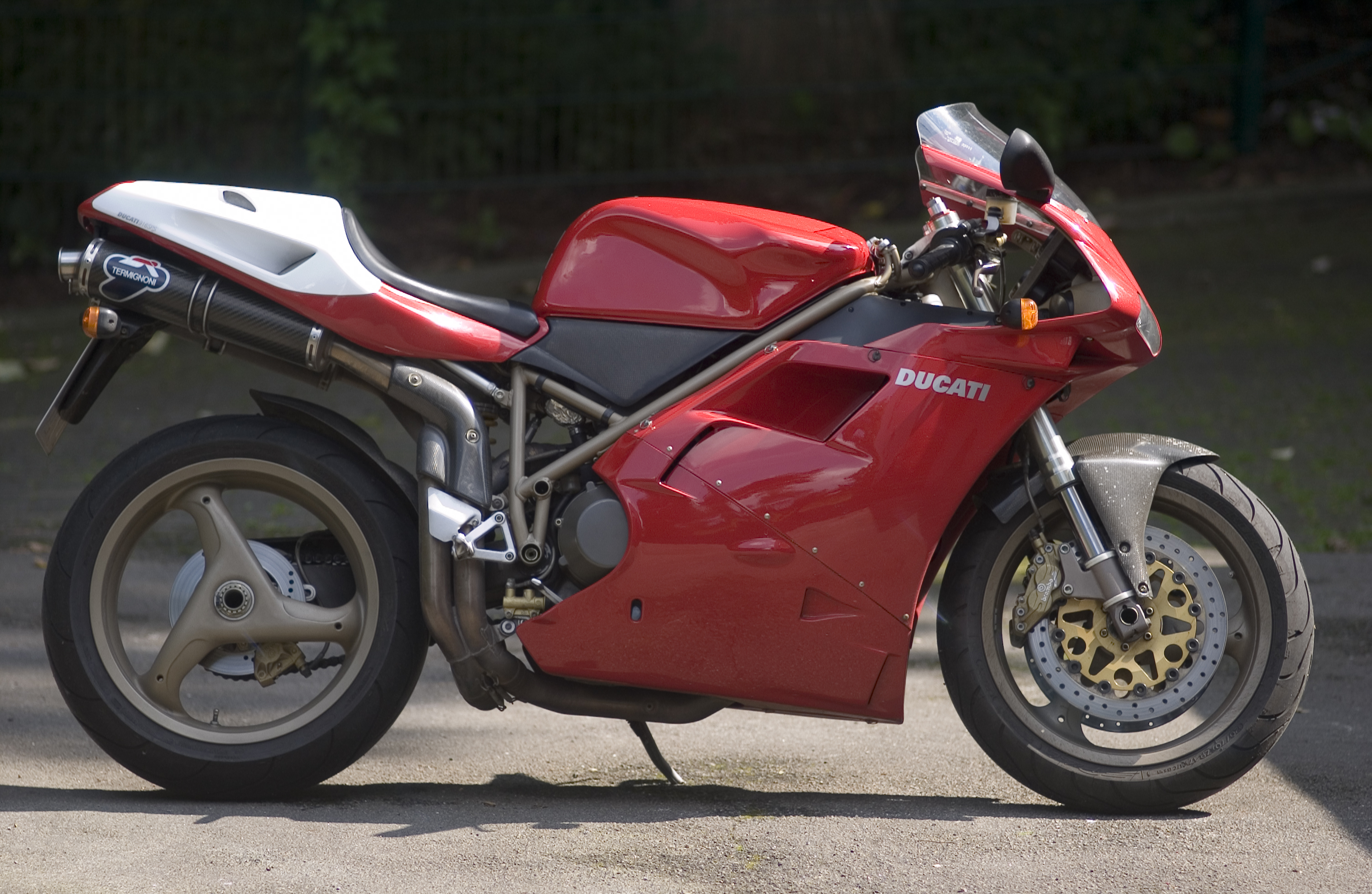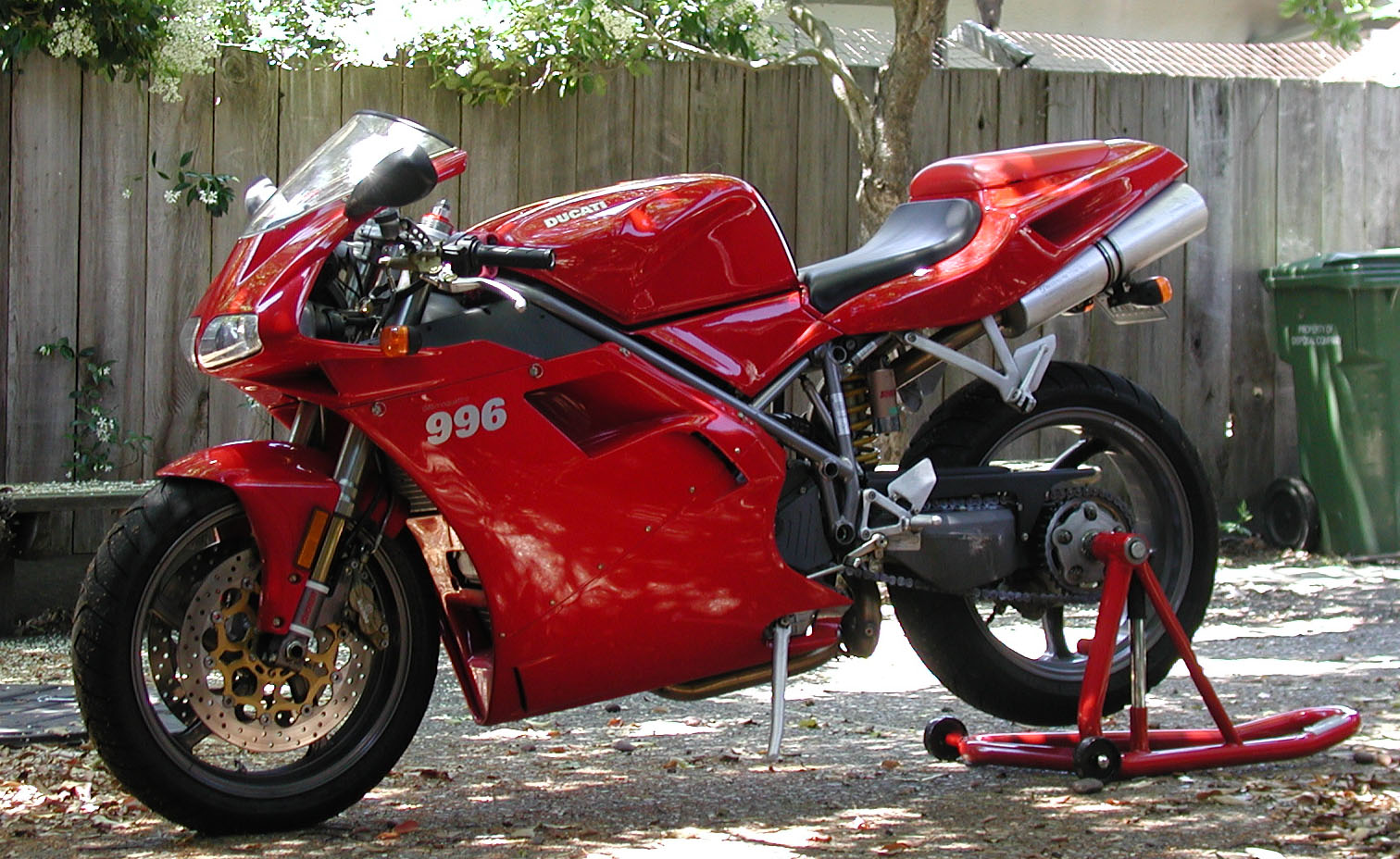|
Ducati Motor Holding
Ducati Motor Holding S.p.A () is an Italian motorcycle manufacturing company headquartered in Bologna, Italy. History Barely a month after the official liberation of Italy in 1944, SIATA announced its intention to sell this engine, called the "Cucciolo" (Italian for "puppy," in reference to the distinctive exhaust sound) to the public. The first Cucciolos were available alone, to be mounted on standard bicycles, by the buyer; however, businessmen soon bought the little engines in quantity, and offered complete motorized-bicycle units for sale. In 1950, after more than 200,000 Cucciolos had been sold, in collaboration with SIATA, the Ducati firm offered its own Cucciolo-based motorcycle. This first Ducati motorcycle was a 48 cc bike weighing , with a top speed of , and had a giving just under . Ducati soon dropped the Cucciolo name in favor of "55M" and "65TL". When the market moved toward larger motorcycles, Ducati management decided to respond, making an ... [...More Info...] [...Related Items...] OR: [Wikipedia] [Google] [Baidu] |
Ducati Mach 1
The Ducati Mach 1 is a 250 cc single-cylinder engine motorcycle, the fastest 250 road bikes at the time. It was capable of just over 100 mph (160 km/h) in full road going trim (lights and silencer). Many were converted for racing use, and in the hands of Alastair Michael Rogers (AKA Mike Rogers) it gave Ducati a TT win when he won the 250 cc production TT. The regulations for the production TT were strict, and Mike Rogers averaged 134.84 km/h on his almost production condition Mach 1 with a fairing and painted green. Mike Rogers was blind in his left eye as a result of a childhood accident, but his efforts and the consistent performance of his Mach 1 enabled him to win. The engine number was DM250M1 00001-01950 and the DM250M1 engine was also used in some Ducati Mark 3s. A total of 838 Ducati Mach 1s were produced, but not many are still in existence as they were also used for racing. References External links Mach 1at Ducati.com Heritage (archived) Mike Rogers profile on ... [...More Info...] [...Related Items...] OR: [Wikipedia] [Google] [Baidu] |
MV Agusta F4 Series
The MV Agusta F4 is an Inline-four engine, inline four-cylinder sport bike made by MV Agusta from 1999 until 2018. It was the motorcycle that launched the resurrection of the brand in 1998. The F4 was created by motorcycle designer Massimo Tamburini at CRC (Cagiva Research Center), following his work on the Ducati 916. The F4 has a single-sided swingarm, large diameter () front Motorcycle fork#Telescopic, forks and traditional MV Agusta red and silver livery. The F4 engine is also one of the few production superbikes to have a Hemispherical combustion chamber, hemi-spherical cylinder head chamber design with 4 valves per cylinder. Engine The F4 engine is a liquid cooled inline four cylinder four-stroke set across the frame with two overhead camshafts (DOHC), 16 'radial' valves, electronic multipoint fuel injection, and induction discharge electronic ignition having engine displacements of , , and . The engine was derived from the 1990–1992 Ferrari Formula One engine. Early in ... [...More Info...] [...Related Items...] OR: [Wikipedia] [Google] [Baidu] |
Massimo Tamburini
Massimo Tamburini (November 28, 1943 – April 6, 2014) was an Italian motorcycle designer for Cagiva, Ducati, and MV Agusta, and one of the founders of Bimota. Tamburini's designs are iconic in their field, with one critic calling him the "Michelangelo of motorbike design". His Ducati 916 and MV Agusta F4 were included in the Guggenheim Museum's ''The Art of the Motorcycle'' exhibit of 1998–1999. He lived and worked in San Marino at the Cagiva Research Center (, CRC), a subsidiary of Cagiva now MV Agusta, from which he retired on December 31, 2008. Early life Tamburini was born on November 28, 1943, in Rimini, where his family were farmers. Although he aspired to attend university, for financial reasons he instead attended the ''Istituto Tecnico Industriale di Rimini'', a technical school in Rimini. According to his biography published by the City of Rimini, he did not finish his technical education for health reasons, and began working at age 18 on heating ductwork. Caree ... [...More Info...] [...Related Items...] OR: [Wikipedia] [Google] [Baidu] |
907ie
9 (nine) is the natural number following and preceding . Evolution of the Hindu–Arabic digit Circa 300 BC, as part of the Brahmi numerals, various Indians wrote a digit 9 similar in shape to the modern closing question mark without the bottom dot. The Kshatrapa, Andhra and Gupta started curving the bottom vertical line coming up with a -look-alike. How the numbers got to their Gupta form is open to considerable debate. The Nagari continued the bottom stroke to make a circle and enclose the 3-look-alike, in much the same way that the sign @ encircles a lowercase ''a''. As time went on, the enclosing circle became bigger and its line continued beyond the circle downwards, as the 3-look-alike became smaller. Soon, all that was left of the 3-look-alike was a squiggle. The Arabs simply connected that squiggle to the downward stroke at the middle and subsequent European change was purely cosmetic. While the shape of the glyph for the digit 9 has an ascender in most modern typefa ... [...More Info...] [...Related Items...] OR: [Wikipedia] [Google] [Baidu] |
Ducati 999
The Ducati 999 is a sport bike made by Ducati from 2003 to 2006. It superseded the Massimo Tamburini designed Ducati 916, Ducati 996 and Ducati 998 range of superbikes. This motorcycle enjoyed great success in World Superbike, and was raced in the series through the 2007 season, despite no longer being produced, pending rules changes by the series' governing body, FIM, to allow competition of the new Ducati 1098. The 999 was designed by Pierre Terblanche, amid much controversy over its styling. It is known as a high performance, race oriented motorcycle. With its traditional Ducati L Twin Desmodromic Valve actuated engine layout, it has a linear power delivery, with high power and torque figures available even at low RPM. Additionally, with its high spec suspension and trellis chassis, it is one of the finest handling motorcycles for its time. The most beloved are the later model Monoposto with SBK rear trailing arm. Subsequently, more powerful 999S and 999R versions we ... [...More Info...] [...Related Items...] OR: [Wikipedia] [Google] [Baidu] |
Ducati 996
The Ducati 996 is a Ducati sport bike motorcycle made from 1999 to 2002, based upon the earlier Ducati 916, 916. Model history From 1999, there were three different models of the 996: a base, or Biposto; the 996S with Öhlins suspension; the 996SPS (Europe only) which had a more powerful engine and less weight thanks to some titanium and carbon fibre parts. From 2001 the 996R replaced the 996SPS and featured the new Ducati Desmoquattro motorcycles#The Testastretta .28996R - 999R.29, Testastretta engine. There was also the Ducati 748, 748, which offered less horsepower. The 996 had larger pistons, larger valves, a stronger crankshaft and crankcases ported from the 916 SPS. But since the 916 camshaft gave a softer, less peaky power delivery and less top-end power ( versus the SPS's ) the 996 was built with a new air intake system with two fuel injectors per cylinder. A new airbox and a distinctive underseat exhaust system were also built into the new desig ... [...More Info...] [...Related Items...] OR: [Wikipedia] [Google] [Baidu] |
Ducati 916
The Ducati 916 is a fully faired sport bike made by Ducati from 1994 to 1998. Featuring a fuel injected, 4-valve, desmo, liquid-cooled, 90° V-twin engine in a trellis frame with a single-sided swingarm and USD forks, the 916 is frequently cited as one of the most beautiful motorcycles ever. Design and development The first development of the 916 model family can be traced back to the development of the four-valve Ducati engine, the Desmoquattro, through the development and racing of the earlier Pantah models, to the road-going 851 and 888 models. The chief designer of Ducati motorcycles since the 1970s was Fabio Taglioni (1920–2001), who introduced the Pantah in 1979. The engine was updated in the 1990s in the SuperSport (SS) series and all modern Ducati engines are derivatives of the Pantah, which used its camshafts to both open and close the engine's valves, eliminating the usual valve closing springs, a system called 'desmodromic'. Taglioni, did not, however, have ... [...More Info...] [...Related Items...] OR: [Wikipedia] [Google] [Baidu] |
Desmodromic Valve
:''In general mechanical terms, the word ''desmodromic'' is used to refer to mechanisms that have different controls for their actuation in different directions.'' A desmodromic valve is a reciprocating engine poppet valve that is positively closed by a cam and leverage system, rather than by a more conventional spring. The valves in a typical four-stroke engine allow the air/fuel mixture into the cylinder (engine), cylinder at the beginning of the cycle and exhaust spent gases at the end of the cycle. In a conventional four-stroke engine, valves are opened by a cam and closed by return spring. A desmodromic valve has two cams and two actuators, for positive opening and closing without a return spring. Etymology The word comes from the Greek language, Greek words ''desmos'' (, translated as "bond" or "knot") and ''dromos'' (, "track" or "way"). This denotes the major characteristic of the valves being continuously "bound" to the camshaft. Idea The common valve spring system is s ... [...More Info...] [...Related Items...] OR: [Wikipedia] [Google] [Baidu] |
Ducati 750SS
The Ducati 750 Imola Desmo is a racing motorcycle built by Ducati that won the 1972 Imola 200 race in the hands of Paul Smart (motorcycle racer), Paul Smart. This win helped define Ducati's approach to racing. Design On March 20, 1970, Fabio Taglioni (September 10, 1920 – July 18, 2001) made the first sketches for the layout of a new Ducati V-twin engine. By April his drawings were completed, and by July, there was a running motor. By August 1970, there was a complete prototype motorcycle. Taglioni engaged Leopoldo Tartarini, the founder of Italjet, to refine the styling aspects of the new Ducati. In October 1970, the decision was made by Ducati to re enter motorcycle competition. Director Arnaldo Milvio and General Manager Fredmano Spairani, were enthusiastic about racing, and had encouraged Fabio Taglioni to develop the 750 V twin. GP V-twins In 1971 five ''500 cc'' V-twins were built to compete in Italian championship and Grand Prix events. Ducati felt that this would de ... [...More Info...] [...Related Items...] OR: [Wikipedia] [Google] [Baidu] |
Giorgetto Giugiaro
Giorgetto Giugiaro (; born 7 August 1938) is an Italian automotive designer. He has worked on supercars and popular everyday vehicles. He was named Car Designer of the Century in 1999 and inducted into the Automotive Hall of Fame in 2002. He was awarded the Compasso d'Oro industrial design award six times, including a lifetime achievement awarded in 1984. In addition to cars, Giugiaro designed camera bodies for Nikon, ''Navigation promenade'' of Porto Santo Stefano, in 1983, the organ of the Cathedral of Lausanne (composed of about 7000 pipes) in 2003, and developed a new pasta shape, "Marille". He also designed several watch models for Seiko, mainly racing chronographs, as well as office furniture for Okamura Corporation. Influence on design Giugiaro's earliest cars, like the Alfa Romeo 105/115 Series Coupés, often featured tastefully arched and curving shapes, such as the De Tomaso Mangusta, Iso Grifo, and Maserati Ghibli. From the late 1960s, Giugi ... [...More Info...] [...Related Items...] OR: [Wikipedia] [Google] [Baidu] |






